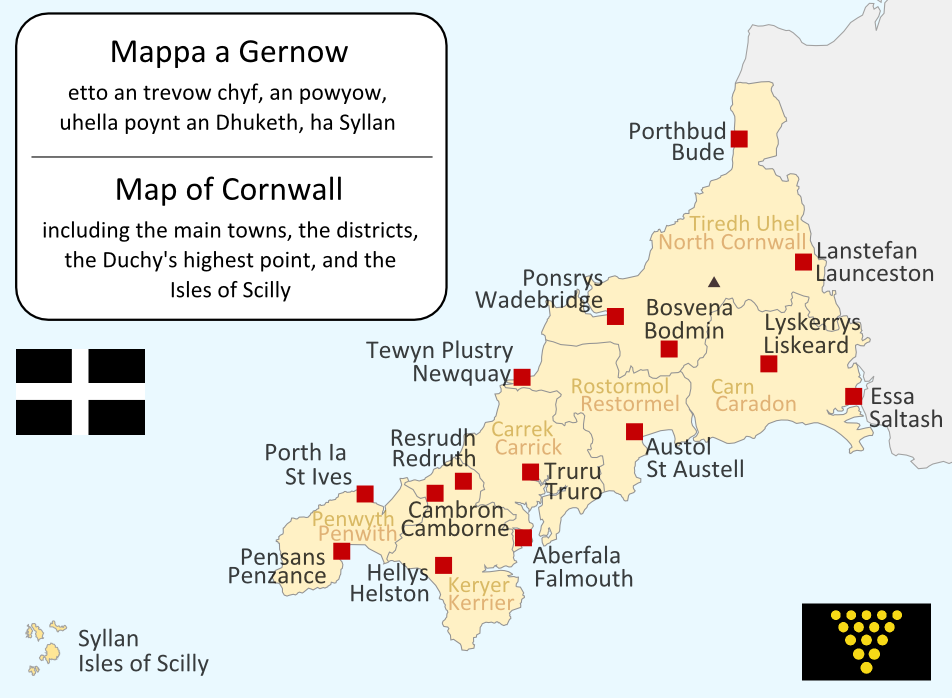Cornwall's Historic Heritage
CORNWALL’S TRUE NAME
by the late Craig Weatherhill
Kernow
The true name of any country is that which is used in the traditional language of that country.
‘Cornwall’ is a hybrid name coined by pre-Norman English scribes and adopted by the subsequent Norman administration.
The Cornish, and therefore true, name for Cornwall is Kernow.
This is of great antiquity and is first found in a Roman record of c.400 AD, within a place-name Durocornouio, “fortress of the Cornovii or Cornish” (identified as Tintagel).
It appears in pre-Norman centuries variously as Corneu and Cerniu, until reaching its modern form, Kernow, in the 13th century. The name is believed to translate into English as “(land of) promontory-dwellers.”
West Saxon records, primarily the Anglo-Saxon Chronicles, show that the early English referred to the Cornish as Westwalas (and to the Welsh as Northwalas), using the Saxon word walas, which they applied to Celtic speaking British natives.
In 891 AD (the same year in which the name England is first recorded as Englaland), the native and Saxon names became hybridised as Cornwalas, hence Cornwall .
The Cornish are a Nation
The late and much missed Cornish archaeologist, historian, Cornish speaker, author and Bard Craig Weatherhill was asked back in 2011 by Nigel Pengelly.
Do we know anything about the Kings of Cornwall?
Craig's answer - Some of them, although details of most are scanty at best. Fragments of a king-list survive, naming those who reigned from about 450 AD to around 650 AD and who would have been associated with the royal citadel at Tintagel, roughly dated to 450-700 AD. The earliest of these was Gurvor, then Tudwal. His successor was Cynvor, who flourished in the early to mid-6th century. Could he be the Cunomorus named on Fowey’s Tristan Stone (Cunomorus is a Latinised form of the Celtic name Cynvor), the lettering of which is dated to 530-570 AD? Could he also be the man mentioned in the 9th century Breton monk Wrmonoc’s Life of St Paul Aurelian as the king Quonomorius, also called Marcus? Was he, therefore, the famous King Mark of Cornwall?
The next king, Constantine, was king when the monk Gildas wrote around 540 AD. He castigated five contemporary British (Celtic) kings and called Constantine: “the tyrannical whelp of the unclean lioness of Dumnonia”. Welsh records refer to him as Custennin Gorneu (“of Cornwall” – an early reference to the native name Kernow). He is said to have abdicated when elderly and gone into the Church. He was succeeded by Erbin, another name which crops up in Welsh tradition as does the name of the next king, Gerent I.
He might have been the Gerent rac Deheu (“Gerent for the south”) who fought against the English at Catraeth (Catterick, Yorkshire) in 598. The next king was Cado, remembered by Geoffrey of Monmouth as Cador of Cornwall. After him come Peredur and Theudu.
The king list fizzles out at this point but we know of Gerent II, possibly Theudu’s successor. In 705, the Synod of Wessex wrote to “Gerontius Rex”, demanding that the Celtic (Columban) Church in Cornwall conform to the doctrines of Rome. That demand was never fulfilled.
After Gerent II is a huge gap of 170 years before we find records of another Cornish king, Donyarth, recorded by the Annales Cambriae as having drowned in 878 AD. The Annales refer to him as “rex Cerniu” (“king of Cornwall”). Fifty years later, we find another one, Huwal, called by the Anglo-Saxon Chronicles “king of the West Welsh”, a term exclusively used to describe the British Celts of Dumnonia and Cornwall (this was not Hywel Dda of South Wales). He was one of several kings who signed a treaty with Aethelstan of Wessex in 928 at Egmont Bridge, following which (and after he’d forced the Cornish from Exeter), Aethelstan fixed the border between Cornwall and Wessex at the east bank of the Tamar – exactly where it remains today in constitutional law (in spite of the unlawful alterations to it by the Boundary Commission and the Ordnance Survey).
Mur ras dhe 'Cornovia'
Magna Britannia: Volume 3, Cornwall
Daniel Lysons & Samuel Lysons
Originally published by T Cadell and W Davies, London, 1814
A brief history of Cornwall
Click on the link for the PDF which will open in a new page Magna Britannia - Cornwall, General History

